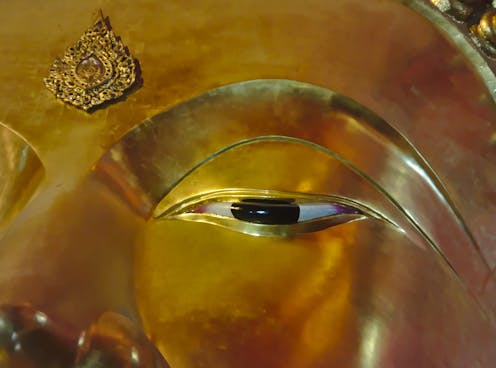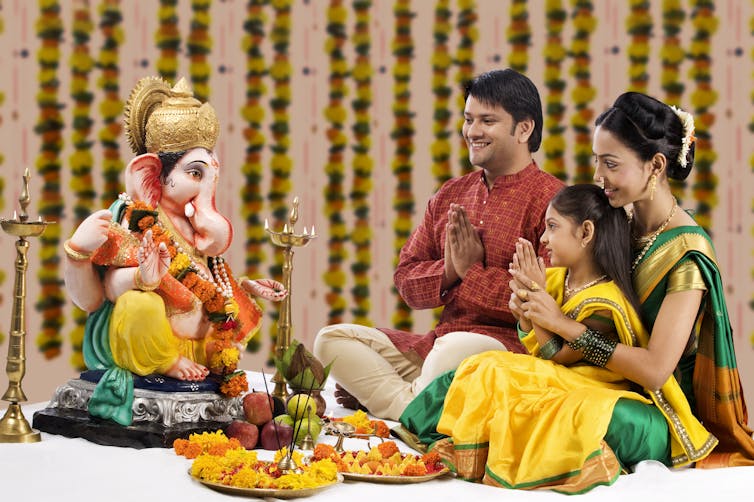How sacred images in many Asian cultures incorporate divine presence and make them come 'alive'
Through the power of rituals, inanimate objects can be understood to transform into agents who can see, hear, taste and respond to the concerns of those who worship them.

Walking into a favorite restaurant here in Knoxville, Tennessee, I was immediately greeted by a golden statue of Buddha, its sparkling gemstone eyes meeting my own as I made my way through the door. The aromas of Thai curries beckoned, but as I was led to a table, I kept thinking about those glinting eyes.
Sacred objects are everywhere: Statues and paintings of gods fill museum galleries and catalog pages alike. You might also see them gracing a neighbor’s yard or upon an altar in your friend’s home.
Some dazzle in bejeweled splendor. Others may appear more humble, their luster softened through generations of hands passing them down. Oftentimes, it can feel as though sacred images are looking back.
I research the ways in which objects express the power of divine presence in Asian religious contexts. Studying different perspectives on sacred objects helps us think beyond religious contexts and allows us to rethink how objects and images play an active role in our lives.
Sacred visual culture
Hindu practice is defined by “darśan” – a ritual act of interacting with the divine through the visual experience. Scholar Diana Eck describes this interaction in her seminal study of Indian visual culture, “Darśan,” in the following way: “to stand in the presence of the deity and to behold the image with one’s own eyes, to see and be seen by the deity.”

Theravada Buddhist rituals in Southeast Asia include all-night chanting sessions to recharge statues’ power. As scholar of Theravada Buddhism Donald Swearer notes in “Becoming the Buddha,” monastics and laypeople in northern Thailand will gather to recite Buddhist sutras while holding cords attached to an image of the Buddha, forming an intricate web of connection between the image and the Buddhist community.
The benefits gained from these chants is understood to enter the statue, recharging its karmic power and reanimating it to once again interact with the community.
Japanese Buddhist statues contain multiple items ritually placed within their wooden cavities: bones of saints, robes from eminent monastics and even silk-fashioned replicas of visceral organs like lungs and kidneys. As art historian James Dobbins notes, certain Buddhist rituals are performed in order to transform the body of a statue into a living body.
In cases like this, inanimate objects are believed to transform into not only sacred things, but also active, living beings who can see, hear, taste and respond to the concerns of those who worship them.
‘Eye-opening’ ritual
There are many different ways to enliven an image, and each ritual tradition carries its own unique process. However, the most well-known across Asia is commonly referred to as the “eye-opening” ceremony. The term “eye-opening” gets its name from the culmination of an intense ritual process wherein the monk paints in the pupils of the image, thus opening its eye to see.
In Sri Lanka, Buddhist monks perform a version known as the netra-pinkama, which loosely translates to “meritorious action of the eyes.”
Richard Gombrich, a scholar of Buddhism and Sanskrit, noted in his study of Buddhism in Sri Lanka that “Before consecration, a statue is treated with no more respect than one would give the materials of which it is composed. … The very act of consecration indicates that a statue is being brought to life.”
Enlivening an image is not a task undertaken lightly, as it is believed in some cases that any demonic spirits loitering around could interrupt the process, thereby resulting in an ineffective ritual or even a malevolent icon. Both the temple grounds and the ritual specialists must undergo purification rites before beginning. The whole process is filled with strict procedures and avoidance of taboos – a common theme among consecration rituals across Asian religious traditions.
Perhaps most importantly, the monk must refrain from looking directly into the icon’s eyes, and thus uses a mirror to look over their shoulder in order to paint in the icon’s pupils.
In Taiwan, statues and paintings of Buddhist, Daoist and local gods will undergo a similar kind of practice known as “kaiguang,” meaning “opening the radiance.” Monks, Daoist masters and even the artists who carve the statues may perform the rite on behalf of the individuals or temple communities that commission the image.
Once completed, shops will wrap a piece of red paper around to cover the statue’s eyes to ensure that the first thing that the image sees is the face of the one who requested it. The power of sacred vision is such that it must literally be kept under wraps.
Living images
Once its eyes have been opened, the image becomes a living thing capable of performing powerful deeds. As such, people may behave much differently – making offerings of incense and taking pains to follow social etiquette lest they offend. The care with which these objects are treated once they have been “activated” suggests that there is a lot more here than meets the eye.
As Eck’s observation attests, being seen is critical to understanding what images do. By seemingly looking back at us, sacred images remind us that we are not alone in this world. In so doing, they also send a message that the world is not there for our eyes only, but that other viewpoints are just as powerful as our own.
Michael Naparstek does not work for, consult, own shares in or receive funding from any company or organisation that would benefit from this article, and has disclosed no relevant affiliations beyond their academic appointment.
Read These Next
Unpaid caregiving work can feel small and personal, but that doesn’t take away its ethical value
Debating whether to step back from a career to take on caregiving responsibilities can be a tough decision…
America faced domestic fascists before and buried that history
Although thousands of Americans embraced fascist ideas during the interwar years, a new study examines…
The next frontier in space is closer than you think – welcome to the world of very low Earth orbit s
The closer to Earth a satellite flies, the clearer a picture it can take of the surface. But low-flying…





